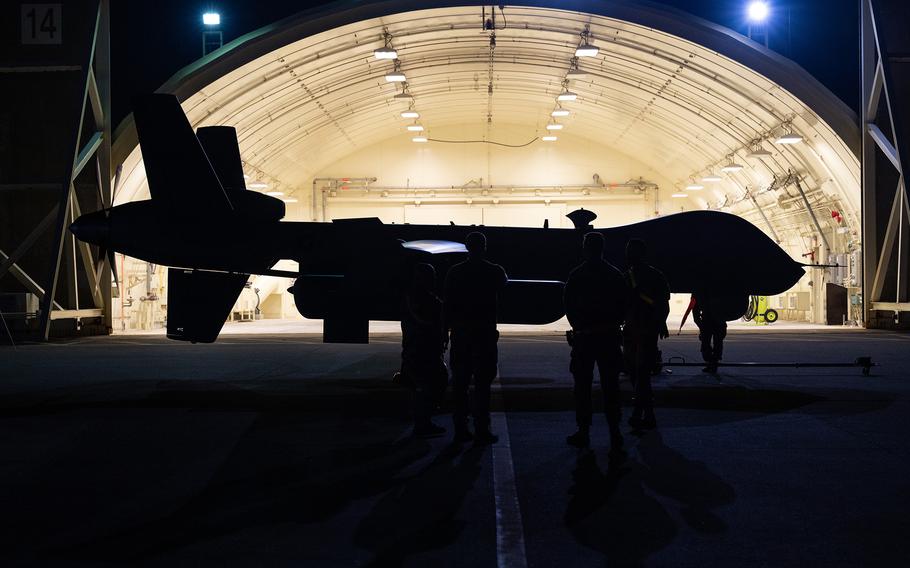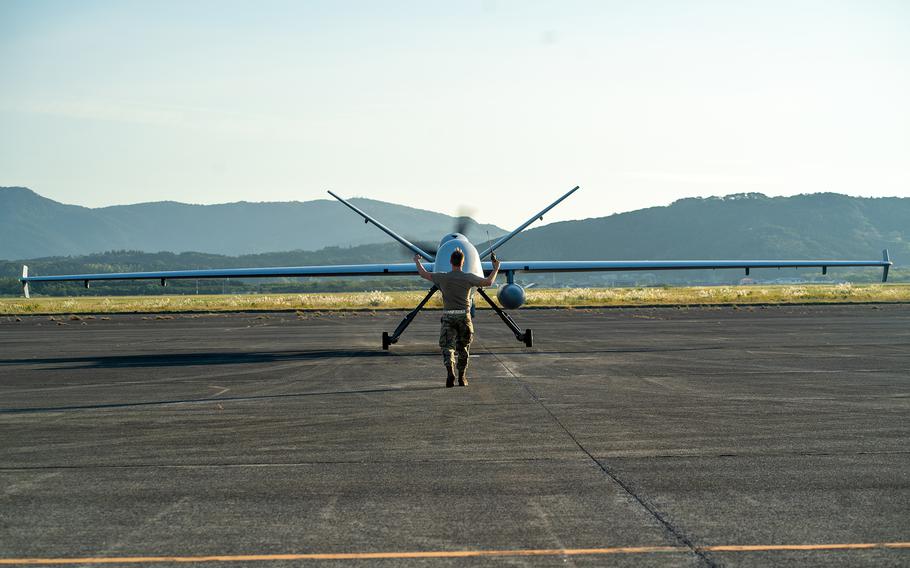
Airmen with the 319th Expeditionary Reconnaissance Squadron prepare to move an MQ-9 Reaper into an aircraft shelter at Kadena Air Base, Okinawa, Oct. 13, 2023. (Tylir Meyer/U.S. Air Force)
CAMP FOSTER, Okinawa — The first MQ-9 Reaper drones have landed at Kadena Air Base on Okinawa, kicking off an open-ended deployment that aims to bring strengthened regional intelligence, surveillance and reconnaissance to Japan’s southern isles.
The first drone, operated by the 319th Expeditionary Reconnaissance Squadron, arrived at Kadena on Friday from Kanoya Air Base, a Japan Maritime Self-Defense Force installation in Kagoshima prefecture, according to 18th Wing spokesman Lt. Col. Raymond Geoffroy.
A second Reaper arrived at the base just before noon Wednesday, a spokeswoman from Okinawa prefecture’s Military Base Affairs Division said by phone that day. Some government officials in Japan speak to the media on condition of anonymity as a requirement of their employment.
The medium-altitude, long-endurance, remotely piloted Reapers are tasked with monitoring potential flashpoints across the Indo-Pacific and providing time-sensitive intelligence to U.S. commanders, allies and partners, including a bilateral intelligence analysis cell made up of U.S. and Japanese military officials, Geoffroy said in a statement emailed Wednesday.
“Our airmen are excited to serve in this challenging priority theater,” Lt. Col. Jordan Smith, 319th Expeditionary Reconnaissance Squadron commander, said Friday in an 18th Wing statement. Deploying to Kadena will provide a more “real-time operating picture.”
It is unclear how many Reapers will operate out of Kadena or how long they will stay. The Air Force does not provide specific aircraft counts or timeframes for their movements, Geoffroy said, citing operational security.
“Several” drones will shift south, according to the wing’s Friday statement; Geoffroy said they would remain for the “foreseeable future.”

An MQ-9 Reaper assigned to the 319th Expeditionary Reconnaissance Squadron taxis at Kanoya Air Base in Kagoshima prefecture, Japan, Nov. 5, 2022. (Christopher Broome/U.S. Air Force)
The Reapers are expected to filter in over the next couple of weeks and begin operating next month, Geoffroy said. MQ-9s are “munitions capable” and can be outfitted with a combination of Hellfire missiles and Paveway laser-guided bombs.
Okinawa Gov. Denny Tamaki called the deployment “unacceptable” and asked the Okinawa Defense Bureau to reconsider, he wrote in a letter Tuesday, which was later posted to the base affairs X profile, formerly known as Twitter.
“The security environment in the Asia-Pacific region is becoming increasingly severe,” Tamaki wrote, but having MQ-9s at Kadena “goes against efforts to lighten the burden of U.S. military bases” on Okinawa.
There is a “heightened need” for information gathering now that potential adversaries are increasing their “activities,” Japanese Defense Minister Seiji Kihara told reporters Oct. 10 in Tokyo. Basing the drones at Kadena will make it quicker and easier to gather intelligence, he said.
The plan to move the Reapers — originally from Creech Air Force Base, Nev., — to Kadena was announced Oct. 6. The newly formed squadron, with its eight Reapers and more than 150 airmen, have been deployed to Kanoya for about a year.
Japan has become increasingly concerned with Chinese militarism and maritime aggression in recent years. Japanese lawmakers in December approved a record defense budget of about $51.4 billion for fiscal year 2023 that emphasizes counterstrike capabilities and strengthens standoff air and missile defense.
They have also placed missile batteries at Self-Defense Force bases throughout the Ryukyu Islands, a chain that includes Okinawa and extends southwestward from Japan’s main islands to Taiwan.